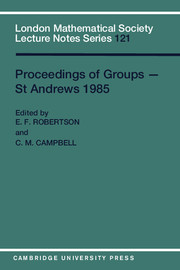Book contents
- Frontmatter
- Contents
- Introduction
- Photograph
- 1 Automorphisms of solvable groups, Part I
- 2 Automorphisms of solvable groups, Part II
- 3 A survey of groups with a single defining relation
- 4 Some algorithms for computing with finite permutation groups
- 5 Five lectures on group rings
- 6 Buildings and group amalgamations
- 7 Finite presentability of S-arithmetic groups
- 8 Efficient presentations of GL(2, ℤ) and PGL(2, ℤ)
- 9 The commutator map
- 10 Polynomial functions and representations
- 11 On questions of Brauer and Feit
- 12 The Picard group and the modular group
- 13 Factor groups of the lower central series of free products of finitely generated abelian groups
- 14 Lattice ordered groups - a very biased survey
- 15 Totally orthogonal finite groups
- 16 One-relator products of groups
- 17 The Cavicchioli groups are pairwise non-isomorphic
- 18 Congruence and non-congruence subgroups of the modular group: a survey
- 19 Small cancellation theory with non-homogeneous geometrical conditions and application to certain Artin groups
- 20 The Lie algebra associated to the lower central series of a group
- 21 Algebraically closed locally finite groups
- 22 On power-commutative and commutation transitive groups
- 23 Dimension function for discrete groups
- 24 Coset graphs
- 25 Nilpotent quotient algorithms
- 26 Generators of p-groups
- 27 On the matrix groups associated to the isometries of the hyperbolic plane
- 28 A characteristic subgroup of N-stable groups
- 29 The isomorphism problem for integral group rings of finite nilpotent groups
- 30 Embedding the root group geometry of 2F4(q)
- 31 On generalized Frobenius complements
- 32 Subgroups of finite index in soluble groups: I
- 33 Subgroups of finite index in soluble groups: II
- 34 Some interconnections between group theory and logic
- 35 Groups covered by abelian subgroups
- 36 Embeddings of infinite permutation groups
- 37 Maximal subgroups of sporadic groups
25 - Nilpotent quotient algorithms
Published online by Cambridge University Press: 05 March 2012
- Frontmatter
- Contents
- Introduction
- Photograph
- 1 Automorphisms of solvable groups, Part I
- 2 Automorphisms of solvable groups, Part II
- 3 A survey of groups with a single defining relation
- 4 Some algorithms for computing with finite permutation groups
- 5 Five lectures on group rings
- 6 Buildings and group amalgamations
- 7 Finite presentability of S-arithmetic groups
- 8 Efficient presentations of GL(2, ℤ) and PGL(2, ℤ)
- 9 The commutator map
- 10 Polynomial functions and representations
- 11 On questions of Brauer and Feit
- 12 The Picard group and the modular group
- 13 Factor groups of the lower central series of free products of finitely generated abelian groups
- 14 Lattice ordered groups - a very biased survey
- 15 Totally orthogonal finite groups
- 16 One-relator products of groups
- 17 The Cavicchioli groups are pairwise non-isomorphic
- 18 Congruence and non-congruence subgroups of the modular group: a survey
- 19 Small cancellation theory with non-homogeneous geometrical conditions and application to certain Artin groups
- 20 The Lie algebra associated to the lower central series of a group
- 21 Algebraically closed locally finite groups
- 22 On power-commutative and commutation transitive groups
- 23 Dimension function for discrete groups
- 24 Coset graphs
- 25 Nilpotent quotient algorithms
- 26 Generators of p-groups
- 27 On the matrix groups associated to the isometries of the hyperbolic plane
- 28 A characteristic subgroup of N-stable groups
- 29 The isomorphism problem for integral group rings of finite nilpotent groups
- 30 Embedding the root group geometry of 2F4(q)
- 31 On generalized Frobenius complements
- 32 Subgroups of finite index in soluble groups: I
- 33 Subgroups of finite index in soluble groups: II
- 34 Some interconnections between group theory and logic
- 35 Groups covered by abelian subgroups
- 36 Embeddings of infinite permutation groups
- 37 Maximal subgroups of sporadic groups
Summary
Four variants of the original nilpotent quotient algorithm for groups are described. All have significant advantages over the versions currently in use.
INTRODUCTION
The coset enumeration and nilpotent quotient algorithms are almost the only group-theoretical algorithms which lend themselves to machine computation. In this note we consider only the NQA. The first paper written on the NQA was [2], and this opened up an entirely new field of study. The success of the NQA may be gauged from the number of papers featuring it which have subsequently appeared. They are too many to list.
Computer technology has greatly advanced in the 15 years or so since the original NQA program was developed. In particular fast access to random entries in very large arrays is not the problem it once was. This suggests that a search for new algorithms, or at least for variants of old ones, designed to take advantage of modern facilities, might be a good idea.
We shall describe four new, closely related variants of the NQA. The last three have been successfully programmed in PASCAL. It seems best to follow the order of actual development in their description, for ease of exposition; in addition to giving practical improvements in NQA implementations, they offer insight into how and why the NQA works.
All four new variants possess the following advantages.
- Type
- Chapter
- Information
- Proceedings of Groups - St. Andrews 1985 , pp. 268 - 272Publisher: Cambridge University PressPrint publication year: 1987



